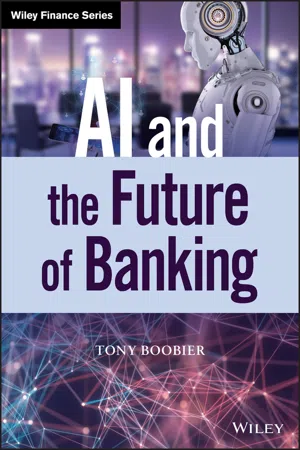
- English
- ePUB (mobile friendly)
- Available on iOS & Android
AI and the Future of Banking
About this book
An industry-specific guide to the applications of Advanced Analytics and AI to the banking industry
Artificial Intelligence (AI) technologies help organisations to get smarter and more effective over time – ultimately responding to, learning from and interacting with human voices. It is predicted that by 2025, half of all businesses will be using these intelligent, self-learning systems. Across its entire breadth and depth, the banking industry is at the forefront of investigating Advanced Analytics and AI technology for use in a broad range of applications, such as customer analytics and providing wealth advice for clients. AI and the Future of Banking provides new and established banking industry professionals with the essential information on the implications of data and analytics on their roles, responsibilities and personal career development.
Unlike existing books on the subject which tend to be overly technical and complex, this accessible, reader-friendly guide is designed to be easily understood by any banking professional with limited or no IT background. Chapters focus on practical guidance on the use of analytics to improve operational effectiveness, customer retention and finance and risk management. Theory and published case studies are clearly explained, whilst considerations such as operating costs, regulation and market saturation are discussed in real-world context. Written by a recognised expert in AI and Advanced Analytics, this book:
- Explores the numerous applications for Advanced Analytics and AI in various areas of banking and finance
- Offers advice on the most effective ways to integrate AI into existing bank ecosystems
- Suggests alternative and complementary visions for the future of banking, addressing issues like branch transformation, new models of universal banking and 'debranding'
- Explains the concept of 'Open Banking, ' which securely shares information without needing to reveal passwords
- Addresses the development of leadership relative to AI adoption in the banking industry
AI and the Future of Banking is an informative and up-to-date resource for bank executives and managers, new entrants to the banking industry, financial technology and financial services practitioners and students in postgraduate finance and banking courses.
Frequently asked questions
- Essential is ideal for learners and professionals who enjoy exploring a wide range of subjects. Access the Essential Library with 800,000+ trusted titles and best-sellers across business, personal growth, and the humanities. Includes unlimited reading time and Standard Read Aloud voice.
- Complete: Perfect for advanced learners and researchers needing full, unrestricted access. Unlock 1.4M+ books across hundreds of subjects, including academic and specialized titles. The Complete Plan also includes advanced features like Premium Read Aloud and Research Assistant.
Please note we cannot support devices running on iOS 13 and Android 7 or earlier. Learn more about using the app.
Information
CHAPTER 1
Prologue: Why Banking?
SUMMARY
- What is meant by the concept of money especially in the digital world
- What is banking in a digital environment
- The breadth of the banking industry, and the key functions within banks such as HR and operations
- Some of the present and future roles in an analytically and AI-infused banking world
Technology Is Changing the Way We Manage Our Money
INTRODUCTION
‘Money, get awayGet a good job with good pay and you're okayMoney, it's a gasGrab that cash with both hands and make a stash'Roger Waters, Pink Floyd, ‘Money’
Everyone, except an economist, knows what money means, and even an economist can describe it in the course of a chapter or so.A.H. Quiggan. A Survey of Primitive Money: The Beginnings of Currency2
- Mankind's ability to be numerate
- The capability to write and therefore to record
- The concept of accountancy, which has allowed both individuals and groups to keep records efficiently in a standardised way, permitting quantities to be tracked
- As a form of barter exchange system
- As a ‘tribute’, such as a form of payment (alongside various debts and fines) to religious and political authorities
- As a method of quantification, where we use the concept of money to quantify ‘value’
- As ‘mana’ or gifting, which in turn relates to the social interaction between giver and receiver, and the importance of money in the nature of social relationships
- As a form of universal language, where money is compared to a ‘system of signs’. Karl Marx described money as ‘the language of commodities’.5
- As a stimulant for violent or conflicting behaviour, not only in respect to power, politics and war (where money seems to sit hand in glove with these concepts) but also in the perceived conflict between employer and employee, buyer versus seller and creditor versus debtor
Table of contents
- Cover
- Table of Contents
- Acknowledgements
- About the Author
- Introduction
- CHAPTER 1: Prologue: Why Banking?
- CHAPTER 2: Imperatives in Banking
- CHAPTER 3: Data and Analytics Primer
- CHAPTER 4: Key Elements of Banking Analytics
- CHAPTER 5: Machine Learning, AI and ‘Apps’
- CHAPTER 6: AI and the Importance of Brand in Banking
- CHAPTER 7: AI Leadership and Employee Transformation
- CHAPTER 8: The Bank of the Future
- CHAPTER 9: Open Banking and Blockchain
- CHAPTER 10: Innovation and Implementation
- CHAPTER 11: Cybercrime and IT Resilience
- CHAPTER 12: Epilogue
- Appendix: Fintech in BankingFintech in Banking
- Index
- End User License Agreement